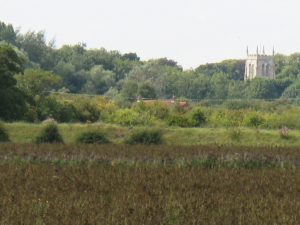Whilst writing ‘Tangible reminders’, I realised that I have not covered the story of the final flight of Wellington Z1410 in any detail. (See ‘VE Day – Patrick’s perspective’ for a brief summary.)
On 29th May 1942, as a demonstration of its growing strength, RAF Bomber Command launched the first of the ‘Thousand Bomber Raids’. The target was Cologne. To reach the total of 1000, every available aircraft was pressed into service. Some of these were old. Some were manned by crews still undergoing training. More than half of the aircraft taking part were Wellingtons.
Patrick’s eldest son Bill was a crew member in one of the 22 aircraft that 142 Squadron despatched that evening. Two of these, both manned by inexperienced crews, failed to return. Bill’s aircraft was caught in searchlights at 16,000 ft. As it took evasive manoeuvres, the port (left) engine cut out. They escaped from the lights at 8,000 ft. They were hit by flak many times. They managed to restart the engine, but it sounded rough on the return trip. In total they were airborne for 3 hours and 52 minutes.
After such a massive effort, the ground crew would have been kept extremely busy repairing damage. Too busy in all probability. Experienced resources would have been stretched thinly. They were accustomed to preparing a single figure number of aircraft each night. Only two days later, 142 Squadron despatched 21 aircraft for a raid on Essen. This is also referred to as a “Thousand Bomber Raid” although the number despatched fell slightly short of this figure. Bill and his crew mates took off in the same aircraft (Z1410) from RAF Grimsby at 23:44. I have to assume that the troublesome port engine had been ground tested. It clearly developed take off power because they cleared the runway. Shortly afterwards, the port engine failed completely. The bombs were jettisoned in the sea. They then attempted to return to base.
The crash report provides a lot of detail, as the excerpts below demonstrate.
“From the evidence of the wreckage, the aircraft struck the ground port wing down and skidding to port. The port airscrew was found feathered and oil on the port tail plane indicated port engine failure. The oil filters of this engine 6106/252373 were examined and it was found to contain a quantity of lead and silver particles. This indicates a bearing failure with possible connecting rod failure. The crash is, therefore, presumed to be due to failure of the port engine.”
“This accident occurred at night at 0022 hrs. 2.6.42 before the moon had risen. The weather was fine and visibility reasonable.
“The accident took place 3 miles from North Coates, Fittes aerodrome and 5 miles from Grimsby aerodrome. Flare paths were laid out at both aerodromes and it is not understood why the pilot did not attempt to land at one of them.”
“One engine of the aircraft, evidently the port, gave trouble soon after take off on an operational sortie. The pilot had carried out the most difficult task of flying out to sea with his bombs and jettisoning them.”
“I consider that this accident was due to the pilot being unable to maintain height on one engine for a long enough period to reach the nearest aerodrome. As he had crossed the coast and passed over North Coates aerodrome the reason for him not doing this must necessarily remain obscure.”
 The record shows that they crashed at Thoresby Bridge, less than 5 miles from the runway back at base just 38 minutes after take-off. Other researchers have pinpointed the site as the adjacent to the intersection of the A1031 and the Louth Canal. It would be perfectly understandable that they were trying to land back at their home base. (Photo taken from the crash site. RAF Grimsby is located to the left of the church tower, just the other side of the low ridge.) They were about two minutes from safety. Only the rear gunner survived the crash and ensuing fire.
The record shows that they crashed at Thoresby Bridge, less than 5 miles from the runway back at base just 38 minutes after take-off. Other researchers have pinpointed the site as the adjacent to the intersection of the A1031 and the Louth Canal. It would be perfectly understandable that they were trying to land back at their home base. (Photo taken from the crash site. RAF Grimsby is located to the left of the church tower, just the other side of the low ridge.) They were about two minutes from safety. Only the rear gunner survived the crash and ensuing fire.
The report questions why the pilot had not attempted to land at the nearer airfield of North Coates. An aircraft with only the starboard engine working will find it almost impossible to make a turn to starboard without losing height. As the crippled plane crossed the coast, North Coates may have been close by, but it was effectively out of reach. If the plane had directly overflown North Coates, then it was probably making a very slow turn to port which the pilot was powerless to prevent, despite the application of full right rudder. Perhaps the pilot finally realised that RAF Grimsby was out of reach and was still hoping to land at the emergency landing ground of North Coates.
